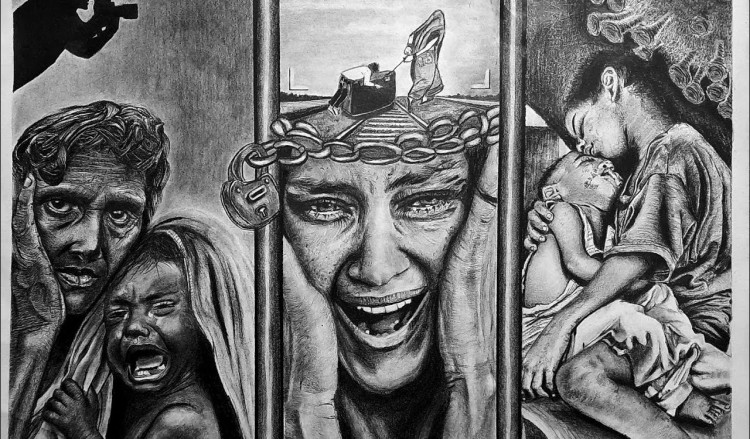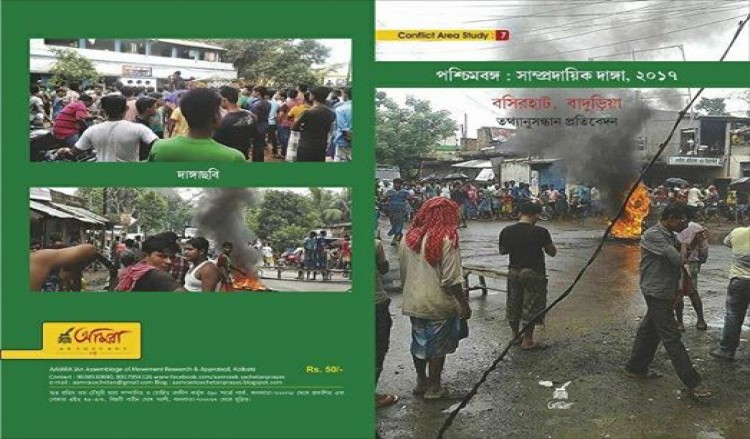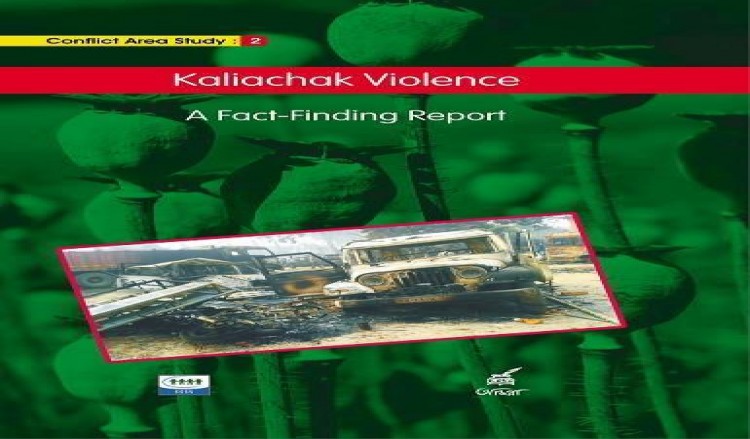
KALIACHAK FACT-FINDING REPORT
‘Your daily life is your temple and your religion’ … Khalil Gibran in ‘The Prophet’ Communal attack by the Muslims or not? A finding of truth … Which way the society going.
KALIACHAK FACT-FINDING REPORT
‘Your daily life is your temple and your religion’ – Khalil Gibran in ‘The Prophet’.
Why Fact Finding of the Kaliachak incident?
On 3rd January 2016, Kaliachak Police Station in Malda District (WB) was attacked by a group. Report of the incident appeared in the media alleging it to be a communal attack by the Muslims. A delegation of the BJP wanted to visit the place, led by its lone MLA in WB, but was not allowed to visit Kaliachak. As WB was soon to face elections for state legislative assembly, all parties were giving it a spin to suit their political interests and ideologies. The TMC called the attack was not communal in nature. Initially the BJP tried to insinuate the attack to be communal with its spokes persons and the General Secretary in-charge of the Bengal unit Shri Siddharth Nath asserting that the media was ignoring coverage of a “major” incident just because the attackers were Muslims and accusing double standards of secularists. They sort of compelled the media to give wider coverage and make a local incident into a national event as the attackers were Muslims. The BJP must have soon realized that communal polarization would not work to its advantage as Muslims have a huge presence and constitute more than 27% of the population of WB. The BJP later also agreed that the attack on Kaliachak Police Station was not religiously motivated; however, it continued to accuse the TMC of protecting the anti-social elements due to its “vote-bank” and “minority appeasement” politics.
Spreading communal cards in the Muslim area is another brand of electoral politics now practiced in West Bengal. Despite Sachar Committee report which indicates pathetic condition of Muslim in West Bengal comparing national level till date a major percentage of Muslim population are engaged in ‘petty, low-income and precarious livelihoods’. Though no pragmatic scheme to eradicate lower socio-economic lack of Muslim is viewed but the allowance for the Imamas and Muezzins are largely propagated. Pre and Post-Kaliachak phase witnessed secret and open activities of different Islamist groups in Maldah. Posters of Asaduddin Owaisi and All India Majlis-e-Ittehadul Muslimeen was noticed in Kaliachak.
In view of accusation and counter accusations, the Centre for Study of Society and Secularism (CSSS), & An Assemblage of Movement Research and Appraisal (AAMRA) decided to visit the place, talk to the stakeholders and prepare a report. The team talked to the victims of the attack, eye-witnesses, bureaucrats, politicians and civil society members. The Team approached the Kaliachak Police Station and tried to talk to police personnel, but they were not ready to talk to the team. The fact-finding was held on 16 February, 2016. The members of the team that visited Malda and Kaliachak thus constituted were
- Irfan Engineer, Director, CSSS.
- Subha Protim Roychowdhury, AAMRA
- Nasmin Akhtar Choudhury, Peace and Justice
- Anupam Das Adhikary, AAMRA
- Jishnu Roychowdhury, APDR
The Context
Radcliffe Award was published on 17th August 1947 – two days after independence – drawing a line to partition the country. The line was drawn in blood and saw bloody population exchange on both sides of the border and mad dance of death producing millions of refugees. Maldah became part of India, however one of its subdivisions – Nawabganj – was included in Rajsahi District of then East Pakistan. Exodus of Hindu and Muslim refugee changed demographic distribution in various locations. North Malda is now a Hindu majority region and south is now Muslim majority.
According to the 2011 census, 51.27% populations of Maldah District are Muslims and 47.99% of populations are Hindus. Among people inhabiting the District there is diversity of tribes and linguistic groups which include Khotta, Panjara, Polia, Shersabadia and Santhals. The Bengali Muslims inhabiting in Malda are largely Sunnis belonging to the Ahle Hadith community. More than 90% of the inhabitants of Kaliachwok-I are Muslims which includes ethnic-linguistic diversity as well as sectarian diversity – Shias and Sunnis.
Kaliachak-I, the bordering block of Malda has a unique geo-political location. The river draining the Eastern Gangetic Plains have higher sediment yield due to lower stream power that impacts in aggradations. The dependency of riverine community on river based economy was largely jeopardized when large scale erosion was started from post-Farakka time. Nearly 4.5 lakh people were homeless in Manikchowk, Kaliachak I, II and III and Ratua Blocks over last three decades. Repeated version of erosion produced SDRR (Settlement-Displacement-Resettlement-Re-displacement) syndrome. The traditional agricultural economy of Kaliachak is therefore in distress. The state has by and large ignored the livelihood problems associated SDRR syndrome. Soil erosion in villages like Mozampur, Jadupur, Dariyapur under Kaliachak I Block was a worst problem and it disrupted the agricultural economy. Here paddy, jute, mustard seeds and varieties of vegetables were the common food and cash crops. The conversion of a fertile (alluvial) land to a Char area (sandy dunes) also converted their agricultural and cultural (agro based) practices.
The displaced and re-displaced population of Kaliachak had little other option but to seek wage employment in the growing trafficking of cattle and drugs across the border with Bangladesh. Phencidil Cough syrup (used as drugs in Bangladesh) is among the top listed commodities for trans-border trafficking. With trans-border trafficking, an illegal network of smugglers-BSF-police-Excise Department-politicians developed. To this, opium cultivation is recent addition. Moazzampur, Dariapur, Sultangunj, Kaliachak town and other parts of the block are also affected. We were told that there are two criminal gangs operating in Moazzampur – Assadullah Biswas and Tuhur Biswas. There are conflicts between them at times. Assadullah Biswas was once with Left and Democratic Front. He has now shifted his loyalty to the TMC, which is not surprising. Quite a few people mobilized for the rally came from Moazzampur.
The growing smugglers-BSF-police-Excise Department-politician nexus is fuelling politicization of religion on both sides of the border. Bordering with Jharkhand, Bihar and Bangladesh ranked Maldah as a hub of inter-state and trans-border trafficking. Post-Shahabag movement in Bangladesh witnessed collapse of the law and order and rise of religious fanatics. Hifazt-e-Islam, an organization in which now leaders and cadres of Jamat-E-Islami have infiltrated got control of the Bangladeshi politics. Bangladesh Awami Olama League a religio-political wing of ruling party demanded Shariyati law like their Hifazati counterpart. We know that Jamaat played the role of Pakistan loyalist and opposed Bangaldesh liberal movement on 1971. Bangladesh witnessed cruel and well planned attack against rationalist bloggers in open space. Hifazat-e-Islam and other Islamist groups were now playing the role to Islamize Bangladeshi national identity. BJP got power in Jharkhand. The growing numbers of RSS camps are noticed in Pakur, Sahibgunj district of Jharkhand. Maldah bordering with Bangladesh got geo-political influence from both sides, east and west.
On the other hand, the Hindutva forces in West Bengal became aggressive after the election of Prime Minister Narendra Modi. The BJP public meetings during and after elections focused on three issues – 1) Gujarat development model (the falsity of which has now been widely exposed), 2) Sharada Chit Fund corruption issue and 3) communal polarization built on the propaganda that Mamata Didi, the Chief the Chief Minister of West Bengal was protecting the Bangladeshi terrorists to appease Muslims which constitute the ‘vote bank’ of the ruling Trinamool Congress Party. Hate campaign against the Muslims was mounted exploiting minor bomb explosions in Khagragarh and other such local conflicts. The growing communal polarization witnessed communal tension in Deganga, Samudragarh, Kakdwip and other places escalating into communal violence. Other issues too were exploited to promote communal polarization and community based politics including Matua, Hindu refugee; Furfura Sharif, self claim guardian of Muslim etc. Growing communal polarization is now a common phenomenon in West Bengal. Insecure Muslim community seeks refuge in their clerics hoping that it would unite the community and so united; they would be able to defend the community. Unity of Muslims then becomes a crying need of the community based on conservative-patriarchal practices. In Maldah, a fatawa was issued by Muslim clerics banning Muslim girls from playing football. The Hindu khaps too rigidly enforce caste based practices. We noticed a kangaroo court (run by Hindu Khaps) at Basirhat Sub-division of North 24 Paraganas District issued a directive to all caste members of the sub-division to boycott a Hindu family for burying a dead. The long established communal harmony and peaceful co-existence based on mutual respect between the communities is coming under increasing strain.
Traditionally, Malda has been a Congress stronghold from the days of ABA Ghani Khan Choudhury. Choudhury is a household name and highly respected in Maldah. He represented the Constituency in the Parliament. He worked to establish Malda Railway Station as the most important railway station of the region. He was first elected as a MLA in 1957 and served as a Cabinet Minister in Govt. of WB from 1972-77. He was first elected as a MP from Maldah in 1980 in the 7th Lok Sabha and was re-elected thereafter till 2004. He died in the year 2006. He was Railway Minister from 1982-89 in Indira Gandhi’s cabinet as well as Rajiv Gandhi’s cabinet. It is with Ghani Khan Choudhury’s efforts that railway equipment manufacturing factory was established in Malda Town. During the 2009 Parliamentary elections, the Congress and Trinamool Congress were in alliance. Mausam, niece of ABA Ghani Khan Choudhury, polled 4,40,264 votes in Malda North while the CPM’s Sailen Sarkar polled 3,80,123 votes.
In the Kaliachak Assembly elections held in the year 2006, Biswanath Ghosh was elected from the CPI (M). From the year 1977 to 2006, CPI (M) won the Kaliachak Assembly constituency in 1982, 1987, 1991 and 2006. Whereas Congress won in 1977, 1996 and 2001. The above data shows that so far as Parliamentary Constituency of Malda South is concerned, Congress has been winning elections. However, the Kaliachak Assembly constituency has more or less a case of revolving chair, with Congress / Trinamool Congress and CPI (M) alternating. The overwhelming Muslim majority Constituency of Kaliachak Block votes alternately for the two dominant electoral parties. The religious identity issues have not been casting a dominant influence in the political behavior of the people of Kaliachak.
Muslim organisations in Kaliachak:
Anjuman Ahle Sunnatul Jamat (ASJ) has been operating in Kaliachak and other blocks of Malda region and enjoys a good reputation among the Muslims of Kaliachak. Though an organization that preaches conservatism among the community, it is not a communal organization that would propagate hatred or even dislike against non-Muslims. Its patriarchal conservatism may be questionable and even undesirable but it appeals to the middle-class Muslims seeking social status and respectability through conservatism. Of recent origin was another organization that was trying to get attention of the community – Idara-e-Shariya. While the former preaches Deobandi brand of conservatism – Salafi-Wahabi Islam which opposes worshipping at graves of sufi saints, the latter preached Barelvi brand of conservatism which does not oppose visits to the dargahs of sufi saints and is culturally more inclusive than the Deobandi Islam seeking strict compliance to the Sharia. In order to gain upper hand, legitimacy and popularity, Idara-e-Sharia was contemplating organizing a protest rally against provocative and derogatory reference to the Prophet of Islam on 1stDecember 2015 by a self-styled Hindu Mahasbha leader Kamlesh Tiwari in UP. There were protest rallies in various parts of the country demanding death penalty to Tiwari. Due to one reason or the other, the protest rally in Kaliachak with 90% Muslim population kept on being postponed. Eid-e-Miladun Nabi – Prophet’s birth anniversary was on December 24, 2015, twenty-four days after the derogatory reference to the holy Prophet. A rally, as is traditional, was organized by Ahle-Sunnatul Jamat in which, it was reported to us, over a lakh people participated. The Jamaat thus proved its mobilizational prowess. Though the Deobandis are roughly about 20% of the Muslim population, they are well endowed and control mosques. The Sunni Imams are mostly from the Deobandi School.
Ethnically, the Barelvis are drawn from the converts from lower caste Muslims or ajlafs whereas the Deobandis are from upper-caste converts – also called as ashrafs. In Malda the Barelvis are largely non-Bengalis and are called as Khotta Muslims and speak Khotta language wherein words are taken from Bengali language but pronunciations are similar to Hindi and Urdu. Khottas recently have been enlisted as OBC community in the state list of Govt. of West Bengal. Khottas are of Bihari origin, where they are also referred to as Khortas. The Idara-e-Shariya Kaliachak was probably trying to increase its influence among the Khottas on account to competitive politics by giving a call for protest rally on 3rd January 2016. The Idara pamphleteered and pasted posters to mobilize for the 3rd January rally for over a week. The rally could not have been opposed by the Jamaat and it did not. Eventually about a lakh Muslims were mobilized from Kaliachak and surrounding villages/towns, including Moazzampur.
No history of communal conflicts in Kaliachak:
Kaliachwok has no history of communal riot since independence. The 3rd January incident too cannot be described as a communal riot. It was not a result of any sustained communal polarization nor did the riot result in communal feelings among Hindus as well as Muslims. The relations between the members of the community continued to be cordial. The target of the rioting mob was neither members of Hindu community nor the two temples on their path. The target of the mob was police station as we shall see later. In fact the victims are staying in the same area and have sympathetic and friendly neighbourhood.
The rally:
People started gathering since about 8.00 am on 3rd January for the rally which included women and children dressed in their new clothes. Presence of women and children shows that there was no intention of violence else women and children would not have been mobilized.
A Hindu eye witness who did not want to be identified and having his house across the street from Kaliachak Police station spoke to the Fact Finding Team. From his house the Police Station premises were visible. He said that the rally commenced sometime around 9.30 am and the people in the rally were carrying effigies of Kamlesh Tiwari. They were shouting slogans like “hang Kamlesh Tiwari”, “Narendra Modi jawab do”, “Nara-e-takdir – Allah ho akbar” etc. He made it clear there were no pro-Pakistan slogans. The participants were also carrying placards, sticks and were excited. There were women and children in the rally. Most of them were not from Kaliachak town.
Around 10:30am another group of 50-70 people appeared in a rally that was carrying lathis (bamboo sticks), hand-shutter-pistol, petrol bomb and hand bombs. They broke the boundary wall of Kaliachak police station, started vandalising and abusing the Police In charge of kaliachak police station Mr. Ram Saha. This group began jumping over the gates of the police station and began torching vehicles in the police station along with the police quarters. The Mob that entered the Police Station seemed to be from Moazzampur belonging to the mafia gang of Assadullah Biswas. The mob attacking the police station was only interested in looting whatever they could lay their hands on. Some from the group attacked the office of police officer Ram Saha. Rapid Action Force barrack inside the police station was set ablaze. Goons flung petrol-bombs inside the police station and burnt an old car parked inside the police station. Stones thrown from the police station hit the house of eye witness as well as about 20 to 30 Hindu houses. A young girl was hit as she was resisting robbing of her father’s scooty. The scooty was eventually burnt. There is a temple within the premises of the police station which is intact but, the eye witness told us that the outer lock on the grill of temple was broken with the intention of robbing some utensils belonging to the temple. Pratap Tiwari, the priest of the temple since 30 years separately confirmed to the team that the lock was broken and utensils robbed but no harm or damage was caused to the temple. It was ironical that even in West Bengal ruled by Left Front there were temples within the police station and expenses for Aartis and Prasad, and salaries of the priest and a help – were all borne by the police station.
We inspected the premises of the police station and found that police quarters housing the BSF were burnt and there was nothing left except the four walls. There was a girl’s hostel inside the police station premise which was vacated and now serves a RAF quarters.
According to the eye-witness, members of the criminal gang opened up the beer bottles and cough syrup bottles that were seized by the police. Some of the empty cough syrup bottles were lying in the sewerage nearby. The eye-witness further said that some Muslims resisted looting but could not stop the looters being professionals. The eye witness further said that Muslims of Kaliachak whom he met after the day of the rally were repentant that such incidents happened during the time of their rally. Now the relations were cordial and normal with the Muslims.
Behind the police station there is Hindu locality living and there is another temple established in the roadside. The vandals started taking out sticks from the boundary fence of the temple where a groups of Hindu boys also appeared on the spot and tried to stop them from taking the sticks, a scuffle broke out and a young boy called Tanmoy Tiwari received a bullet on his limb. However, this was disputed by the administration. Admittedly, there was no FIR lodged in the police station of the bullet injury. We talked to the parents and sister of Tanmoy Tiwari and they said that he was not targeted by the mob. Tiwari went to prevent the mob from pulling out sticks from the fence of a temple and in the melee somebody fired and Tiwari received bullet injury on his foot. Tiwari was, according to the family, recuperating in a hospital in Kolkata. Tiwari’s family did not expect anything from the government, even compensation. They had signed an application prepared by Adv. Asit Baram Choudhury in English regarding the incident to be filed in the police station but according to Adv. Choudhury, the police refused to register his complaint. Tiwari’s parents or sister was not aware of the contents of the application though they had signed the application out of trust for Adv. Choudhury. We asked Addl. DM in Malda who did not want to be identified about the incident. The ADM denied there was any firing during the rally.
Eye witness and victim Subodh Singho Roy’s small roadside kiosk was situated behind the police station. The kiosk was burnt on the fateful day. He gave us the following account:
There were about 1½ lakh people in the rally on 3rd January. His shop was open and the rally passed off peacefully. However, later a mob came and set his shop afire in which all his bank papers, furniture, all the goods in his kiosk like betelnuts, pan masala sachets, peppermints and biscuits for the children. The fan in his shop was also burnt. Subodh Roy pegged his losses to Rs. 1½ lakhs, though he could not substantiate his claim with documents and precise calculations.
According to Roy, the people of second group broke the dilapidated wall of the Police Station. They were carrying brickbats and kerosene, and were burning documents and records of the Police Station. Two groups of rally was reported by local eye-witness, first was ‘peaceful’ and aged persons, children with colorful dresses and festoons and they were shouting slogans demanding punishment to Kamlesh Tewari. They were also shouting “Muslman ek ho!” (Muslims unite). He too said that there were no slogans like ‘Pakistan zindabad’ (Hail Pakistan). The second rally was provocative and violent, targeting the Police station in particular.
Communalization of the incident:
We talked to a local lawyer Adv. Asit Baran Choudhury who seemed to be holding Hindu nationalist perspective, although he did not disclose his link with any Hindu nationalist organization if he had one. The BJP and the Hindu nationalists exploited the situation to vilify Muslim community as a community of criminals having scant respect for law and fanatical about their religion. They also exploited the situation to vilify the ruling TMC and other secular parties as protectors of these lawless community endangering the security of the country only for vote bank politics. They wanted to communally polarize the society in West Bengal and bay for polarized Hindu votes. What was essentially an attack on police station by mafia to destroy the documents and records pertaining to criminal cases in which they or their god fathers may have been implicated was exploited by the Hindu nationalists to vilify the entire Muslim community.
In order to achieve their objective, they spread rumours and propagated lies to increase anxiety among the Hindus so that it is easy to make them hate non-Hindus, particularly Muslims. Though we could not obtain a copy of the leaflet circulated by the VHP, the TMC leaders Mozahar Hossain and Prabir Bose told us that Gautam Sarkar of VHP circulated a leaflet accusing Muslims to be harassing Hindu women. The brave Hindus (they are only about 10% in Kaliachak) fought and warded off the alleged attacks. The leaflet, according to Mozahar Hossain, exaggerated the damages to Hindu temples even though no damages were caused to the temple. BJP mounted a high voltage propaganda all over India by claiming that the Kaliachak attack was not condemned enough by the secularists only because the perpetrators were Muslims.
Those who haven’t visited Kaliachak and talked to the victims would get the impression that there was a major attack and break down in law and order in West Bengal due to appeasement of Muslims by the TMC Govt. Media, particularly the Z-News played skewed role branding the incident as a communal incident between the two communities. A section of media projected Muslim as culprits, who destroyed temples, murdered the priest and burnt Hindu houses. However, we found the temples untouched, priest not touched, and the houses were in good condition as they were before.
After talking to the Hindu victims we were convinced that the attack was neither communal, nor in any sense of the term a major attack. Criminals burnt down a few vehicles in the police station precincts, burnt down RAF quarters and belongings of the RAF personnel housed therein and burnt the criminal records. Any violence is of course condemnable. But attack on police and police stations have happened in the life of the nation often. A group of people having grievances against the Govt. routinely indulge in arson and targets of their attacks are police vehicles, Govt. buses and often police personnel and police stations. Several attacks on police and police stations during the anti-reservation agitation in Gujarat in 1984-85, the Jat agitation in Haryana, Gujjar agitation in Rajasthan, Patidar agitation in Gujarat or a Shiv Sainik Kalgude beating up a woman traffick cop because she stopped him while he was talking on his mobile while driving, a Muslim cop beaten up a group of Shiv Sainiks in Latur celebrating Shiv Jayanti in violation of law are but a few examples which the Hindu nationalists have ignored and in some cases even clandestinely supported.
Interview with Adv. Asit Baran Choudhury:
Adv. Choudhury seemed to be exaggerating the damage caused vilifying the entire Muslim community that they always patronized criminals and harboured separatist mentality which was reflected in the rally and burning down of the police station. He said that earlier cow was being exported in large numbers to Bangladesh with the knowledge of the administration. However cow export required huge capital and only rich traders could do it. When that was stopped by the Central Govt., they (the Muslims) shifted to fake currency. When action against fake currency was also taken, they resorted to poppy cultivation. Poppy cultivation, according to Adv. Choudhury was well organized and undertaken by well armed people and the entire business was controlled by D-company (referring to Dawood Ibrahim) and therefore it endangered security, posed threat to national integration and encouraged terrorism. He told us that 10 y ears ago there were posters of “Mugahalistan” were pasted on the walls showing a map that included WB, Jharkhand and Bihar. Why would territory of “Moghulistan” be so limited and that too focusing on the eastern region is beyond us. The Muslims, according to Adv. Choudhury, displayed loyalty to Muslim rulers and treated Hindus as second class citizens. Height was when he claimed that a mob from the rally tried to enter his house and they threw bombs inside the premises of his house and bullets were fired. Though he showed the place where bombs fell in the open porch of his house and spots were bullets hit, there was not even a scratch, let alone burnt marks and bullet marks. His bias was also notable from his assertion that Muslims are always Muslims first and then Indians and they were still termed as secular Indians whereas even when Hindus practiced their religious rituals were termed as communal.
Interview with Mozahar Hossein, leader of TMC.
Mozahar Hossein told us that those who attacked the police station were criminals and not part of the rally. They took advantage of the rally. The venue of rally was far away from the police station. He said that if police showed them the video footage, they were ready to identify all those who were captured by the camera so that they could be brought to justice. The attack, according to him, was to burn down records and documents and they even robbed a few uniform of the police personnel. Had the Muslims in such a massive rally desired to harm the temple and surrounding Hindu houses, they could have caused considerable damage given their number and capacity. Mozahar Hossein admitted that he had not visited Hindu victims of violence and that was because he was afraid that he would be implicated in the case due to his religious identity. That contention was difficult to believe and digest. Victims did not blame the Muslim community for the violence. They were dissatisfied with the administration for not taking effective steps to secure them. Mozahar Hossein and other leaders of TMC did not visit the victims even long after peace and normalcy had been restored. As we were leaving the TMC office, the Hindu victim – Subodh Singho Roy – visited the TMC office, in all probability to request for compensation for his burnt down shop.
Interaction with the ADM (G) at Maldah
We talked to the ADM (G), Debatosh Mondal. The ADM told the team that everything was alright in Kaliachak and that the incident was not communal. He further was complicit that peace had been restored and appropriate action was being taken and would be taken against all those involved in the violence. According to him, there was no gun firing during the 3rd January incident and the police records did not mention any such firing during the incident. When we told him that we had met the family of Tiwari who allegedly received bullet injury on his foot and they testified before us regarding such firing, he replied that gun firing was ordinary and common occurrence in Kaliachak and therefore need not be related to the 3rd January rioting. We were surprised that a responsible official on such a high post casually termed the incident of alleged gun firing in such nonchalant and dismissive manner as a normal and ordinary incident not warranting serious concern of the state. Such an attitude reflects ordinariness and normalization of violence in the state of West Bengal, whether political, communal or criminal intimidation of law abiding citizens. Normalization of violence frightens us and poses a great danger to the democracy and rule of law in West Bengal.
Observations and conclusions:
The Fact Finding Team arrived at the following observations:
- The attack on the police station was not planned by the organizers of the rally. All eyewitnesses said so. Even Choudhury did not allege that the organizers of the rally had pre-planned the attack. Although he vilified the entire Muslim community as criminals and such an attack was to be expected whenever they organize their rallies.
- Criminals seemed to have taken advantage of the rally, and behind the cover of the rally carried out their attack on the police station. Their target was not any member of the Hindu community but the police station and criminal records therein. Their target was also the RAF personnel quarters. They seem to have reacted to the crackdown on their illegal activities. They were also interested in looting whatever came their way, including Phencidil cough syrup, beer bottles and police uniforms.
- The role of the media on the whole, with exceptions of course, was deplorable. Media coverage of the attack on Kaliachak Police Station by criminals who happened to be Muslims, was given communal overtones and portrayed as if the incident was a national disaster under the influence of Hindu nationalists and their propaganda. Worst and more violent attacks on state properties and on police occur in which non-Muslims are involved and they do not receive national coverage on the scale that the Kaliachak incident received. On account of the scale of media coverage, even the secular minded prominent citizens and civic and political organizations from all over the country felt obliged to condemn the attack as if it was communally motivated and of national significance.
- Competition between two organizations – Ahle Sunnatul Jamaat and Idara-e-Sharia – to hegemonize and control the Muslim community seems to be the motive behind the organization of the rally which ultimately led to attack on Kaliachak Police Station. Such competitive mobilization and any reaction to any provocation should be avoided to defeat the communal politics. The more these organizations react to provocation, the more elements from Hindu nationalists are encouraged to provoke the community by publicizing derogatory remarks against Muslims and their Prophet. Such provocations must be fought legally rather than on streets. At times Muslim community organizations pick up issues more out of political objectives rather than reverence for the Prophet.
- We could not independently corroborate the fact whether Tanmoy Tiwari received bullet injuries during the rally. However, we noticed that Tiwari’s family, as indeed other Hindus continued to stay in their usual homes. There was no insecurity or fear of neighbouring Muslims. We did not notice any bitterness for Muslims in the parents of Tanmoy or other Hindu victims. Upon asking the incidence of bullet injury of Tanmoy Tiwari, police denied any such incident happened and ADM accepted that gun firing was common incidence in Kaliachak. We note with sadness “the matter of fact” manner in which the administration took incidence of firing as normal. It discloses the failure of law and order situation.
- We note with pain the criminal-police nexus and the normalcy and the way in which the serious crimes are taken with a casual attitude. The state has done pretty little to ameliorate the dwindling livelihoods of the people due the riverine draining of alluvial soil from the gangetic planes. The administration has not responded to SDRR syndrome. The unemployed are used by the criminals as labourers in their “industry”. The Hindu eyewitness told us that as a result of growing poppy cultivation, the vegetables have become costly as the area under food crop is going down.
- The attack on police station was neither communal nor did it result in communal polarization.
- Pro-active measure to promote peace and strengthen relations between different communities would have to be undertaken. The initiative from the political parties – even TMC and CPI (M) was lacking to say the least.. Hindu nationalists are trying their level best to misuse the violent attack on Kaliachak police station to create fear among Hindus about Muslims by demonizing them as violent-criminals-terrorists-anti-nationals-prowling upon Hindu women. They are thus trying to communally polarize the situation for political objectives. Different Muslim groups also entered in the phenomenon and trying to organize Muslim. This needs to be countered in the long run, even though the Hindu nationalists haven’t yet fully succeeded in their designs. Legal action needs to be taken against them for the offence of promoting enmity, ill-will and hatred between Hindus and Muslims and openly publishing and distributing such leaflets. Such attempts also needs to be countered politically by dispelling such propaganda by secular political forces and exposing the political designs of the Hindu nationalists
- Members of Muslim community should have met the victims whose shop was burnt down and offered token compensation. However, they were worried that they would be accused by the Hindu community of their complicity in the violence.
- The owner of the kiosk that was burnt down during the violence must be compensated by the state. And state should play its role to restore normalcy and make an end to the nexus for trafficking. The perpetrators of the Kaliachak violence must be brought to justice and punished.
Note of differences
Here the team members would like to record differences among them. Subha Protim Roychowdhury and Anupam Das Adhikary from AAMRA felt that the overtone in TMC leader Mozahar Hossein’s speech echoed biased. The role he played from post-violence period is questionable.
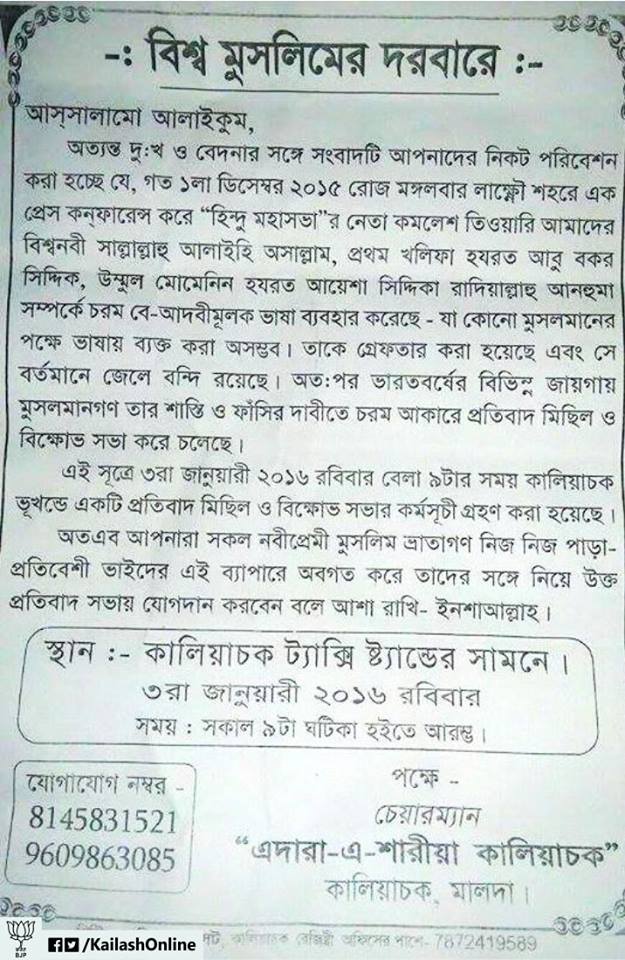
A Leaflet Distributed on behalf of Edara-E-Shariya Kaliachak before 3rd January, 2016 incident took place.
Annexure
Leaflet of Edara-E-Sharia Kaliachak
Assalamu Alaikum
With deep grief the news hereby distributes to you that on 1 December, 2016, Tuesday at Luknow in a Press Conference leader of ‘Hindu Mahasova’, Kamlesh Tewari used derogatory language to our Prophet (Sallallahu Alaihi Wasallam), First Khalifa Hazrat Abu Bakr (R.A), Ummul Momineen Hazrat Ayesha Siddiqa (R.A); for any Muslim it is impossible to utter. He was arrested and now he was in Jail. Therefore all over India, Muslims organized protest rally and agitation programme demanding his punishment and death penalty.
In accordance with above a protest rally and agitation meeting was programmed on 3rd January, 2016, Sunday at 9 a.m at Kaliachak land.
So, all the Nabi lovers, Muslim brothers will inform their neighbours and will hopefully attend with them - Insallah.
Contact No. – 8145831521 Place - Before Taxi Stand, Kaliachak
3rd January, 2016, Sunday Time - From Morning 9a.m it will start
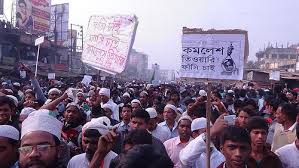
The protest rally, demanding death penalty as punishment on 3rd January, 2016 (Picture Source - Internet)

The Leaflet distributed on behalf of Hindu Jagran Manch, Dakshinbanga, immediate after 3rd January Incident (page-1)
 The Leaflet distributed on behalf of Hindu Jagran Manch, Dakshinbanga, immediate after 3rd January Incident (page-2)
The Leaflet distributed on behalf of Hindu Jagran Manch, Dakshinbanga, immediate after 3rd January Incident (page-2)
“West Bangladesh” introduced at Maldah
On 3rd January at Kaliachak of Maldah a group of Muslim Jehadists attacked Kaliachak Police Station, damaged all files of Police Station, looted rifles from stockroom and then burnt the Police Station. Including jip car of Police and Border Security Force they also burnt the cars of common people totaling twelve by number. Police narrowly saved their life. After burning that police station those hooligans attacked nearby Hindu village, Baliapara. They looted villages, bombing and firing continued. Two innocent villagers injured by bullets are now struggling for survival in the hospital.
Kaliachak is a Block located near Bangladesh Border. It is heaven for fake currency, opium and trafficking. The badsah of this Mafia Raj is now the leader of ruling party, Bokul Sekh. Asadullah Biswas, another leader of ruling party leaded to loot Police Station on 3rd January. All the evidences of their crime were burnt by this incident. The vast area in the Bangladesh border is unsafe. How many antinational terrorists used that incident to infiltrate is not known. When Indian Army was killed by Pakistani militants, exactly then in West Bengal upsurge against state was started.
But here is no tension. It is quiet normal in present day West Bengal. After getting power Chief Minister granted 10500 Khariji Madrasha. Simulia Madrash was born. At Khagragarh it was the party office of ruling party where jihadist activity for bomb-making was grew up. At Gardenrich the labour leader of ruling party and his son, a student leader was caught as Spy of Pakistan. Party in power shows no responsibility. They are busy for Imam and Muajjem allowance and felicitation of Pakistani Gazal singer. Frank confession by Chief Minister came in, “we got power for you. Vote bank must be intact. And majorities Hindus are just like goats, easy to get their votes.”
No coverage was noticed in the Anadabazar and other media. Why? The issue is sensitive. Dadri is not sensitive, Gujrat riot?
|
|
They can easily publish article, picture on those matters. But when Hindus are attacked, killed, women are raped by Muslims at Bangladesh, Deganga, Naliakhali, Juranpur- these are treated as sensitive. The readers of Anadabazar could not inform the cruel incident. Before the last Hindu's journey to crematorium, no media news will disclose.
The intellectuals, poets, performers cried for Dadri are silent now. The murder of poor scheduled caste Hindu at Juranpur is not communalism; incident of kaliachak is not intolerance? What a selfish, grabby, coward are those so-called intellectuals are!
This week ISI declared capturing India is just a time factor. Kaliachak may be its 'acid test'. As this state is the softest target in the country. Such a brazen politics, self-seeking media are nowhere in India.
Everyday Hindus are victimized by the jihadists at Bangladesh. Everyday mother before her daughter and daughter before her mother are raped. Hindu property is captured, whole family members were butchered in day light. No judicial system. Maldah incident proves this part of Bengal will face it soon.
Friend, what you will do now? Will you wait for “West Bangladesh”? Or you question those traders of politics, why you make Khagragarh, Gardenrich for your petty interest? Be united and call the owner of Newspaper, journalists to stop it. Open the mask of so-called intellectuals and tell them not to further contaminate Bengal. Our bloody oath not converts West Bengal as West Bangladesh.
Campaigned by: Hindu Jagaran Manch, South Bengal, 76/2 Bidhan Sarani, Kolakta-9
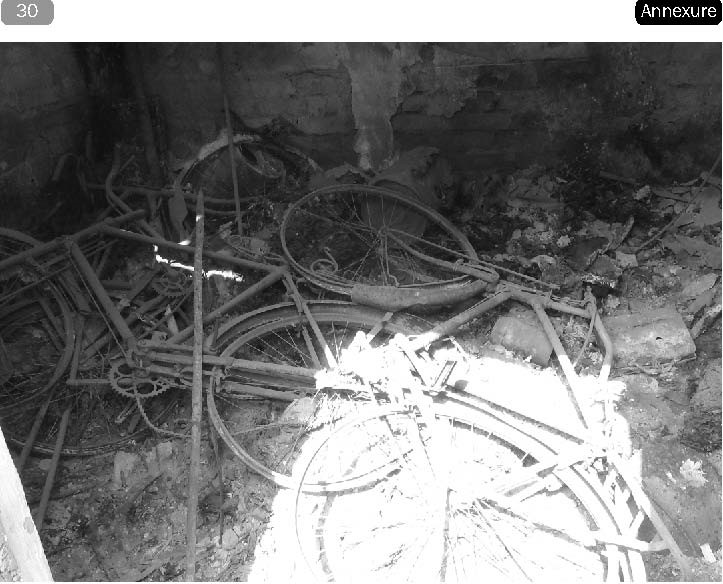 Burnt Bicycles & other Belongings of Kaliachak Police Station
Burnt Bicycles & other Belongings of Kaliachak Police Station
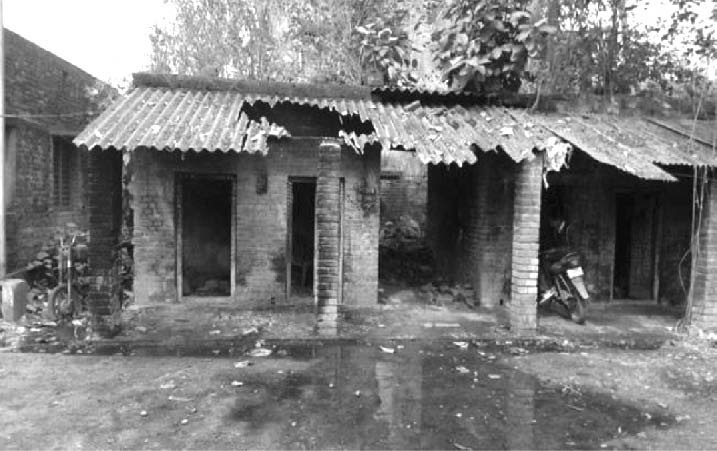 Kaliachak Police Station premises after Incident
Kaliachak Police Station premises after Incident
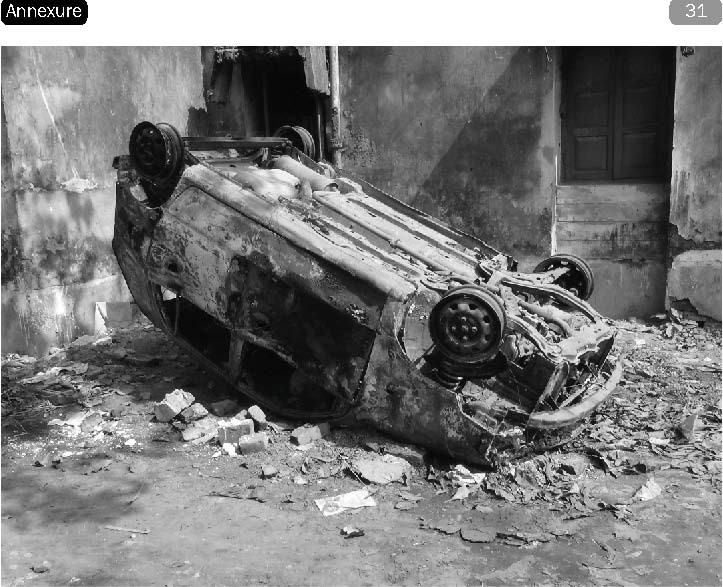 One of many burnt vehicle inside Kaliachak police station
One of many burnt vehicle inside Kaliachak police station
.jpg) Priest Subodh Singho Roy describing about the incident. In front of the Kali temple (inside Kaliachak P.S premises)
Priest Subodh Singho Roy describing about the incident. In front of the Kali temple (inside Kaliachak P.S premises)
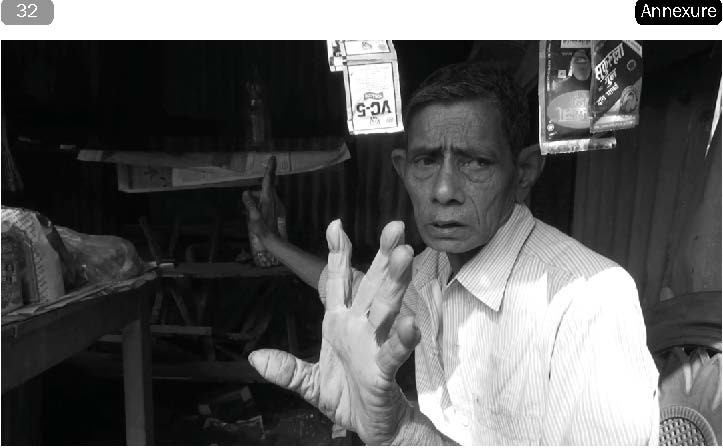 Victim Subodh Singho Roy sharing his experience of that day.
Victim Subodh Singho Roy sharing his experience of that day.
_Leader_of_Kaliachak_Nr__Mozahar_Hossein__(Objection_against_him_is_not_taken_any_peace_initiative_).jpg) Discussion with Ruling Party (TMC) Leader of Kaliachak Nr. Mozahar Hossein. (Objection against him is not taken any peace initiative.)
Discussion with Ruling Party (TMC) Leader of Kaliachak Nr. Mozahar Hossein. (Objection against him is not taken any peace initiative.)

আমরা: এক সচেতন প্রয়াস
AAMRA is an amalgamation of multidisciplinary team of researchers and activists erstwhile worked as an assemblage of movement, research and activism. Popular abbreviation of AAMRA is, An Assemblage of Movement Research and Appraisal.-

পশ্চিমবঙ্গ : সাম্প্রদায়িক দাঙ্গা, ২০১৬
‘অল্প হিন্দু থেকে বেশি... -

Say no to war, let peace be our only path
We strongly oppose this war. We unequivocally state... -
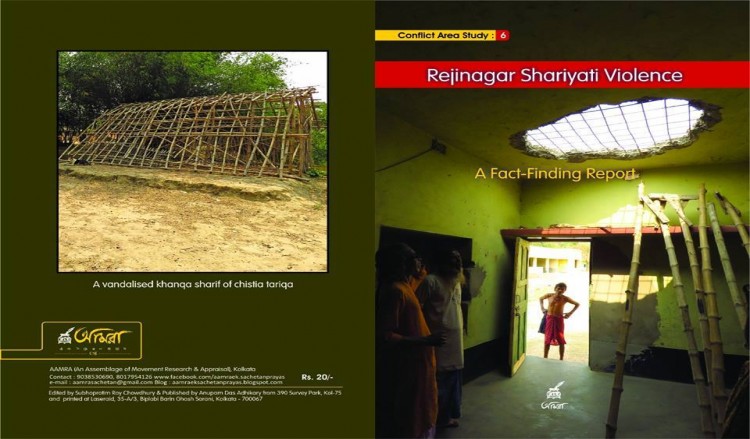
Rejinagar Shariyati Violence
In contemporary Bengal, one of the most important trends... -
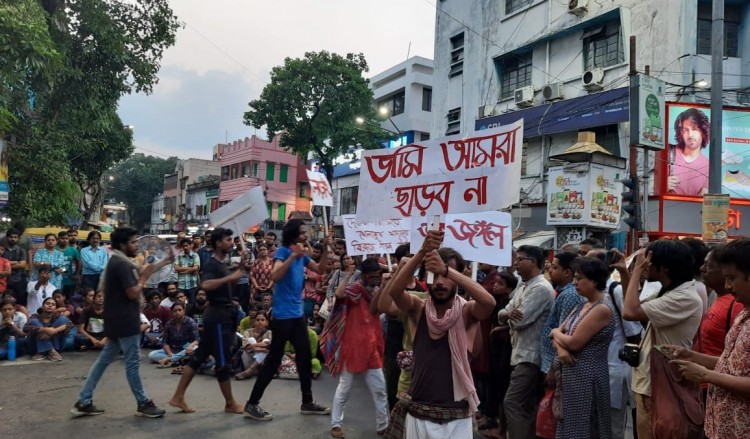
Rally to celebrate World Environment Day, Kolkata, 5 June, 2022
‘Environment Rights Movement’, a platform of different...
